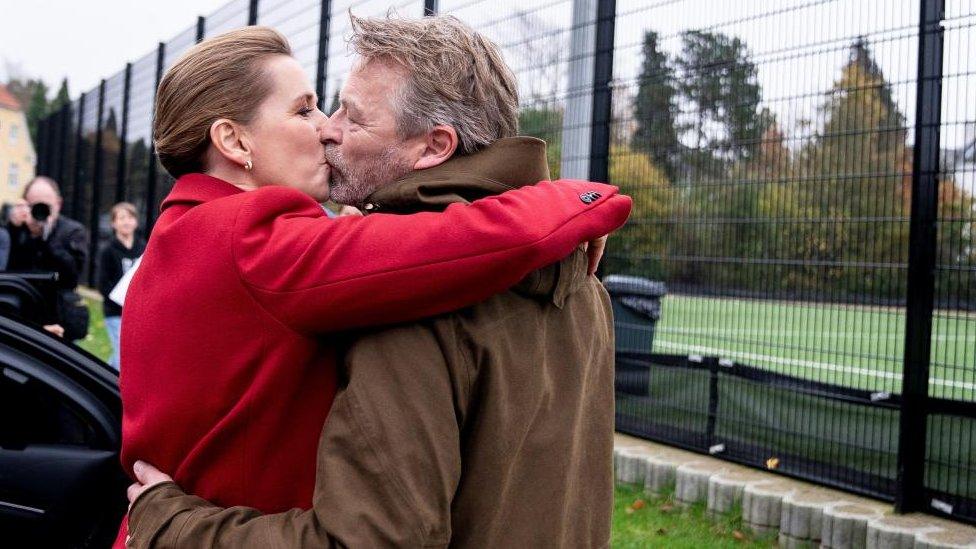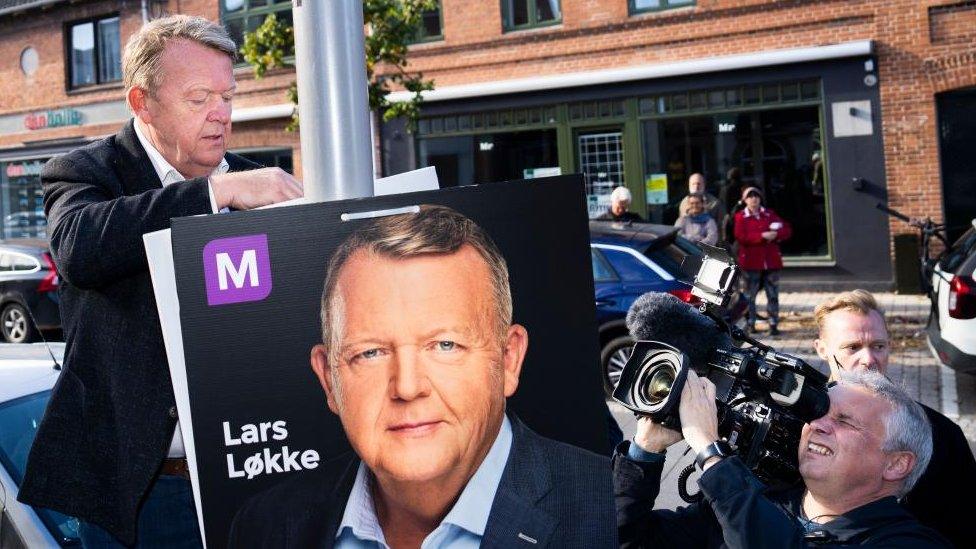Mink cull and TV drama: Five things to watch in Danish election
- Published

Prime Minister Mette Frederiksen gave her husband a kiss after voting in Tuesday's election
If your knowledge of Danish politics is limited to the fictional intrigues of TV drama Borgen, Tuesday's snap national elections might seem a case of life imitating art.
It's not just that a female prime minister is fighting to stay in power in this battle for the centre ground. A new party has emerged as potential kingmaker with a very similar name to the fictional Moderates who rose to power on TV.
Here are five things to watch in Tuesday's vote.
PM seeks to escape shadow of Mink cull
Mette Frederiksen has led Denmark through its response to Russia's invasion of Ukraine and the Covid-19 pandemic, but it was her government's controversial decision to cull up to 17 million mink because of a mutated form of the virus that led to Tuesday's snap election.
The cull destroyed Denmark's world-leading mink industry and last July led to a parliamentary reprimand for the prime minister because there was no legal basis for the slaughter.
Ms Frederiksen was found not to have known the order was illegal so she and her Social Democrat party are favourites to win the vote, but they'll need to assemble a coalition of 90 seats in the 179-member Folketing. Fourteen parties are running and polling stations close at 20:00 (19:00 GMT).
Life imitating art
When Borgen burst on to TV screens around the world 12 years ago, it propelled the fictional centrist Moderates (De moderate in Danish) party led by Birgitte Nyborg to power.
In Tuesday's election, a new party also called Moderates - but with the more colloquial Danish name Moderaterne - is aiming to become kingmaker.
Led by former prime minister Lars Lokke Rasmussen, the Moderates have been doing well in the opinion polls and could play a key role in deciding whether the left-of-centre "red bloc" or the right-of-centre "blue bloc" led by Jakob Ellemann-Jensen's Liberals form the next government. Where it gets interesting is that neither bloc looks like it will secure an immediate, outright majority.

Lars Lokke Rasmussen touts the purple alternative - with an eye on being kingmaker after the vote
"We aren't blue, we aren't red - we've mixed the colours, we're purple," says Mr Rasmussen, eyeing an opportunity. But unlike Birgitte Nyborg, the chances of him winning power are minimal.
Immigration not a factor
Unusually, immigration has not really figured much at all in this election campaign - and the far-right Danish People's Party may not even hit the 2% threshold for entering parliament.
That doesn't mean it's not still relevant in Denmark, just that healthcare, rising inflation and security are considered far more important. All the main parties have backed a deal with the Rwandan government to look into sending asylum-seekers to Rwanda for their applications to be processed.
On the eve of the vote the Liberals' rapporteur on immigration said the Rwanda policy would probably never happen, after internal documents were published in Danish media highlighting poor human rights conditions in the East African country.
Health as top issue
Hospitals and healthcare have been highlighted as the main preoccupation for Denmark's 4.27 million voters, with hospitals short of some 5,000 nurses and more than half of those in jobs working part-time.
Part of the problem is low pay and thousands of posts in the social care and healthcare sectors are unfilled. Many Danes in rural areas fear losing their family doctors.
Many voters undecided
The 14 party leaders were pushing for votes right until the end of a TV debate on Monday night - because opinion polls suggested as many as one in seven voters were undecided by the eve of the election.
Election watcher Martin Vinaes Larsen from Aarhus University said that number could be as high as 30%, leaving an unusually uncertain political landscape.
It all adds up to a sense that it is very hard to predict who will end up in power in Denmark.
Related topics
- Published21 December 2020
